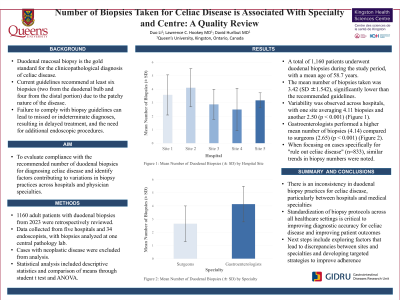Tuesday Poster Session
Category: General Endoscopy
P4120 - Number of Biopsies Taken for Celiac Disease is Associated With Specialty and Centre: A Quality Review
Tuesday, October 29, 2024
10:30 AM - 4:00 PM ET
Location: Exhibit Hall E

Has Audio

Lawrence Hookey, MD
Gastrointestinal Diseases Research Unit, Queen's University
kingston, ON, Canada
Presenting Author(s)
Duo Li, BSc, David Hurlbut, MD, Lawrence Hookey, MD
Gastrointestinal Diseases Research Unit, Queen's University, Kingston, ON, Canada
Introduction: Duodenal mucosal biopsy is the gold standard for the clinicopathological diagnosis of celiac disease. Given that the disease can be patchy, multiple endoscopic biopsy samples (minimum 2 from duodenal cap and 4 from mid to distal portion) are recommended for histopathology assessment to support or exclude the diagnosis. The aim was to assess the number of endoscopic duodenal biopsies obtained from patients with a clinical suspicion for celiac disease and explore factors associated with postulated biopsy number variability.
Methods: Retrospective review of all duodenal biopsy cases obtained in 2023 from adult patients (18 years of age and older) undergoing upper gastrointestinal (GI) endoscopy performed at 2 academic and 3 community hospitals by gastroenterologists and surgeons. Pathology assessment of all cases was completed at one academic hospital pathology laboratory and reported by one of several GI subspecialty pathologists. Individual pathology reports were reviewed for patient age, endoscopist (including specialist type), procedure location, clinical indication for endoscopic examination, duodenal biopsy number and biopsy location (duodenal cap; mid to distal portion), total duodenal biopsy number, and pathology diagnosis. Cases with neoplastic disease were also excluded from analysis. Statistical analysis included descriptive statistics and comparison of means through student t test and ANOVA.
Results: 1160 patients had duodenal biopsies performed during the study period. The mean age was 58.7 (17.7) years. 34 individual endoscopists from 5 hospitals were part of the cohort. 48.4 per cent of samples were submitted by surgeons. When all duodenal biopsies were considered, the mean number of biopsies taken were 3.42. Gastroenterologists submitted a higher mean number of biopsies than surgeons - 4.14 (1.35) versus 2.65 (1.35) (p< 0.001). Differences were also seen when hospitals were compared, with one hospital having the highest mean number at 4.11 (1.4) ranging down to the lowest at 2.5 (1.57) (p< 0.001). When only duodenal biopsies submitted with the question “rule out celiac disease” were considered (n=833 patients), results were similar.
Discussion: This study shows that duodenal biopsy patterns are not meeting standards, even when specifically assessing for celiac disease, with differences seen between centres and specialties. Next steps will include targeted interventions to attempt to correct.
Disclosures:
Duo Li, BSc, David Hurlbut, MD, Lawrence Hookey, MD. P4120 - Number of Biopsies Taken for Celiac Disease is Associated With Specialty and Centre: A Quality Review, ACG 2024 Annual Scientific Meeting Abstracts. Philadelphia, PA: American College of Gastroenterology.
Gastrointestinal Diseases Research Unit, Queen's University, Kingston, ON, Canada
Introduction: Duodenal mucosal biopsy is the gold standard for the clinicopathological diagnosis of celiac disease. Given that the disease can be patchy, multiple endoscopic biopsy samples (minimum 2 from duodenal cap and 4 from mid to distal portion) are recommended for histopathology assessment to support or exclude the diagnosis. The aim was to assess the number of endoscopic duodenal biopsies obtained from patients with a clinical suspicion for celiac disease and explore factors associated with postulated biopsy number variability.
Methods: Retrospective review of all duodenal biopsy cases obtained in 2023 from adult patients (18 years of age and older) undergoing upper gastrointestinal (GI) endoscopy performed at 2 academic and 3 community hospitals by gastroenterologists and surgeons. Pathology assessment of all cases was completed at one academic hospital pathology laboratory and reported by one of several GI subspecialty pathologists. Individual pathology reports were reviewed for patient age, endoscopist (including specialist type), procedure location, clinical indication for endoscopic examination, duodenal biopsy number and biopsy location (duodenal cap; mid to distal portion), total duodenal biopsy number, and pathology diagnosis. Cases with neoplastic disease were also excluded from analysis. Statistical analysis included descriptive statistics and comparison of means through student t test and ANOVA.
Results: 1160 patients had duodenal biopsies performed during the study period. The mean age was 58.7 (17.7) years. 34 individual endoscopists from 5 hospitals were part of the cohort. 48.4 per cent of samples were submitted by surgeons. When all duodenal biopsies were considered, the mean number of biopsies taken were 3.42. Gastroenterologists submitted a higher mean number of biopsies than surgeons - 4.14 (1.35) versus 2.65 (1.35) (p< 0.001). Differences were also seen when hospitals were compared, with one hospital having the highest mean number at 4.11 (1.4) ranging down to the lowest at 2.5 (1.57) (p< 0.001). When only duodenal biopsies submitted with the question “rule out celiac disease” were considered (n=833 patients), results were similar.
Discussion: This study shows that duodenal biopsy patterns are not meeting standards, even when specifically assessing for celiac disease, with differences seen between centres and specialties. Next steps will include targeted interventions to attempt to correct.
Disclosures:
Duo Li indicated no relevant financial relationships.
David Hurlbut indicated no relevant financial relationships.
Lawrence Hookey: Pendopharm – Consultant.
Duo Li, BSc, David Hurlbut, MD, Lawrence Hookey, MD. P4120 - Number of Biopsies Taken for Celiac Disease is Associated With Specialty and Centre: A Quality Review, ACG 2024 Annual Scientific Meeting Abstracts. Philadelphia, PA: American College of Gastroenterology.
